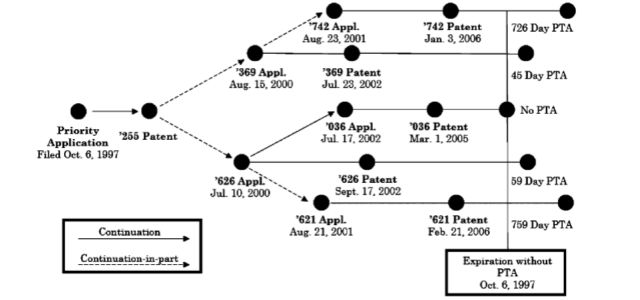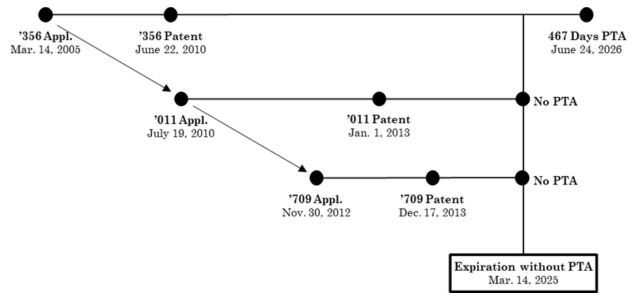It is very common for patentees to have multiple granted patents within the same patent family, and due to patent term adjustment (PTA), one or more of those patents could expire well beyond the expiration date of other patents in the family. However, what if an earlier-filed, later-expiring patent (e.g., a “parent” patent with PTA) could be invalidated simply because there are later-filed, earlier-expiring “child” patents in the family? That has been a growing concern in the patent community over the past few years.
In In re Cellect, for example, the Federal Circuit concluded that the Patent Trial and Appeal Board (PTAB) did not err in finding that the claims of several earlier-filed, later-expiring patents were unpatentable on the grounds of obviousness-type double patenting (ODP) in view of a later-filed, earlier-expiring patent. That case arose from reexamination proceedings in which the examiner rejected certain claims of Cellect’s ’621 patent, ’626 patent, ’742 patent, and ’369 patent on the grounds of ODP for being unpatentable over the claims of Cellect’s ’036 patent. The relationship between these patents is as follows:

Cellect’s ’036 patent was the only family member that did not receive PTA and thus expired earlier than its family members.
On appeal, the Federal Circuit held that ODP “for a patent that has received PTA, regardless [of] whether or not a terminal disclaimer is required or has been filed, must be based on the expiration date of the patent after PTA has been added” (In re Cellect, LLC, 81 F.4th 1216, 1229 (Fed. Cir. 2023). As a result, the court concluded that the PTAB did not err in finding that the earlier-filed, later-expiring patents were invalid under ODP.
This decision sent shockwaves through the patent community and had many patentees scrambling to determine whether their patents, the term of which had been extended by PTA, were safe from an ODP attack. On August 13, 2024, the Federal Circuit provided some clarity.
In Allergan USA, Inc. v. MSN Lab’ys Priv. Ltd., No. 2024-1061, 2024 WL 3763599 (Fed. Cir. August 13, 2024), the Federal Circuit stated that its holding in In re Cellect relates to the expiration date of a patent rather than the circumstances under which a claim can properly serve as an ODP reference:
Our holding in Cellect is only controlling in this case to the extent that it requires us to consider, in our ODP analysis, the ’356 patent’s June 24, 2026 expiration date (i.e., the expiration date after the addition of PTA)… It does not follow, however, that the ’356 patent must be invalidated by the ’011 and ’709 reference patents simply because it expires later. Indeed, Cellect does not address, let alone resolve, any variation of the question presented here – namely, under what circumstances can a claim properly serve as an ODP reference – and, therefore, has little to say on the precise issue before us. (Id.at *6; emphasis in original).
In a footnote, the Federal Circuit stated that “Cellect cannot be read as ‘confirming,’ much less holding, that a later-filed, later-issued, earlier-expiring claim is a proper ODP reference against a first-filed, first-issued, later-expiring claim having a common priority date.” (Id.).
In Allergan, the court evaluated whether claim 40 of the ’356 patent, the expiration date of which had been extended by 467 days due to PTA, was invalid on the grounds of ODP over certain claims from its “child” patents (the ’011 patent and the ’709 patent, referred to collectively herein as “the reference patents”). The relationship between the ’356 patent and the reference patents is as follows:

The court found that the claims of the reference patents are not proper ODP references that can be used to invalidate claim 40 of the ’356 patent. (Id.). In reaching its decision, the court focused on the fact that the ’356 patent was the first patent to cover the claimed subject matter. The court noted that it is the first-filed, first-issued patent in a family that sets the maximum period of exclusivity for the claimed subject matter and any patentably indistinct variants. (Id.). Therefore, the court held that “a first-filed, first-issued, later-expiring claim cannot be invalidated by a later-filed, later-issued, earlier-expiring reference claim having a common priority date.” (Id. at *7).
This decision appears to settle the ODP issue only as it relates to the specific facts in this case, given that the court stated that its holding was specific to those facts. Thus, patentees should still be cautious of the ODP implications when PTA is awarded to a patent that is not the first-filed, first-issued patent or when the involved patents are from different families.

Written by Ronald C. Kern Jr., PhD.
Partner, BakerHostetler
You may also like…
Pravin Anand conferred with the APAA Enduring Impact Award
Pre-eminent IP Lawyer and Managing Partner of Anand and Anand, Mr Pravin Anand, has been conferred with the...
The quiet power of confidentiality clubs in SEP litigation
In standard essential patent (SEP) disputes, especially those involving FRAND (Fair, Reasonable, and...
A $10 million patent win reduced to a $1 lesson in damages
In a decision that will resonate as a stark warning to patent litigants, the US Court of Appeals for the Federal...
Contact us to write for out Newsletter














